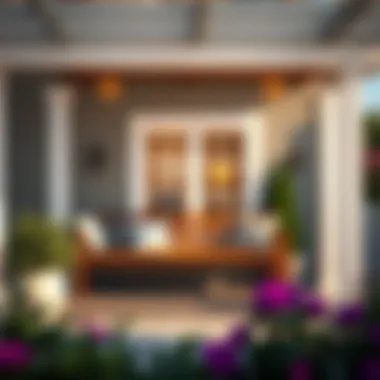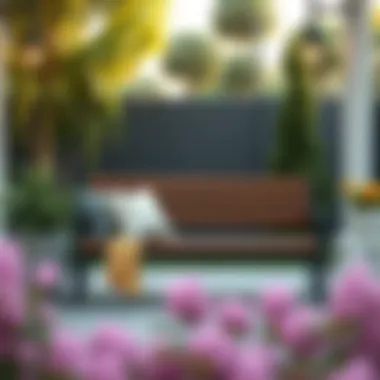The Versatility of Porch Seating Benches for Outdoor Spaces


Intro
Porch seating benches are not just utilitarian pieces of furniture; they represent an intersection of aesthetics and functionality that can dramatically transform outdoor spaces. Homeowners and designers alike are increasingly recognizing the value of these versatile benches, which serve multiple purposes beyond mere seating.
There’s a certain charm in a well-placed bench on a porch, inviting both relaxation and social interaction. These benches can be the heart of gatherings, a sanctuary for quiet moments, or a stylish statement piece that enhances the overall design of a home. With a myriad of styles and materials available, it's important to look into the specific needs and aesthetic preferences when choosing the right bench.
This article will explore the many facets of porch seating benches, covering trends in design, material choices, and practical applications. We aim to provide insights tailored not only for homeowners looking to enrich their garden but also for designers and DIY enthusiasts eager to incorporate such benches into their projects. As we delve deeper into this topic, you’ll gain a clearer understanding of how to blend functionality with style, adding value to your outdoor settings.
Preface to Porch Seating Benches
Porch seating benches are more than just pieces of furniture; they embody the spirit of outdoor living, enhancing not only our physical spaces but also our social interactions. These benches serve a multitude of purposes—from providing a cozy nook for morning coffee to transforming into a gathering point for evening conversations. Emphasizing their significance requires delving into several facets such as design, comfort, and practicality.
Some people might see porch benches simply as utilitarian items; however, when chosen thoughtfully, they can elevate the entire ambiance of a porch or patio. Just picture a sturdy, well-crafted wooden bench adorned with vibrant cushions on a sunny morning—it invites you to take a seat and soak in the fresh air. That’s the power of a porch bench; it shapes experiences and memories, becoming a staple in the fabric of outdoor life.
When selecting a porch bench, one must be mindful of key elements such as size, material, and style. These components not only dictate the bench’s appearance but also its functionality. For instance, a smaller bench suited to an intimate space allows for ease of movement, while a longer one can accommodate gatherings of family and friends.
The aesthetic of the bench should also harmonize with the overall design of your home. Depending on one's preferences, options ranging from modern minimalism to rustic charm allow for a personalized touch. Uniting practicality with design ensures that your choice contributes positively to the outdoor environment.
"A well-chosen bench can turn an ordinary porch into an inviting escape, fostering connection and relaxation."
In addition to aesthetics and comfort, the materials used in constructing porch benches affect their durability and maintenance. With choices spanning wood, metal, and composite materials, it’s essential to consider weather resilience as well. For instance, a metal bench may endure harsh climates better than a wooden one, but it also brings its own visual appeal.
Ultimately, porch seating benches play a pivotal role in outdoor living. They invite tranquility, serve as a gathering space, and bridge the gap between indoors and outdoors. Thus, understanding their multifunctionality transcends mere decoration; it becomes a pathway to enhancing our lifestyles. As we explore the various aspects of porch benches throughout this article, we will uncover the intricacies involved in choosing the perfect piece for one’s outdoor sanctuary.
The Evolution of Outdoor Seating
The evolution of outdoor seating reflects both the changes in our society and the shifting ideals of comfort, style, and function. Understanding this journey is not merely a glimpse into the past; it provides essential insights into how we can enhance our current outdoor spaces with benches that blend aesthetic appeal with utility.
Considering the developments that outdoor seating has undergone, one can appreciate the deeper significance of these pieces. From simple stools made out of natural materials to finely crafted wooden or metal structures, each phase of this evolution represents an adaptability to cultural trends and environmental conditions. Ultimately, the multi-purpose nature of modern porch seating benches emerges as a solution to the need for comfort during social interactions, relaxation, and storage.
In contemporary design, outdoor seating aims not just to serve a functional purpose but also to foster community and connection. How we design and position our porch benches can alter the dynamics of communication, providing intimate spaces for conversations or gathering points for whole families. Moreover, as outdoor living becomes an extension of our interiors, the consideration of comfort and style on porches is now treated as vital as it once was indoors. In short, the evolution of outdoor seating expresses a broader societal shift towards multifunctionality and meaningful engagement in our living environments.
Historical Overview of Porch Furniture
Delving into the rich history of porch furniture offers a fascinating narrative that sheds light on how porch seating has been molded over decades. During the early colonial period, practical needs dictated furniture designs. Simple, robust benches made from durable woods were common. These early forms might not have been the epitome of style, but they served an essential purpose in daily life.
As culture evolved, so did the aesthetics of porch furniture. By the Victorian era, ornate designs began to creep into outdoor settings. Craftsmanship flourished, leading to intricately wrought iron details and elaborately carved wooden benches which reflected the grandeur of the time. This trend toward beauty alongside functionality created outdoor spaces that were not merely utilitarian but also symbolized social status and personal taste.
Fast forward to the mid-20th century, when the mid-century modern movement introduced clean lines and simplicity into porch seating. This design philosophy melded practicality and beauty, opening the door for new materials like plastics and tubular metals. The benches from this era embodied a spirit of leisure, encouraging relaxed outdoor living unlike in times past.
Today, the landscape of porch furniture is a blend of these historical influences, layered with new-age materials and eco-friendly practices. Designs have become more diverse, with options to suit every taste—from the cozy, rustic look to sleek, modern lines. Different materials—from recycled plastics to sustainably sourced woods—are used to create seating that looks appealing while respecting the environment.
Supporting this journey through different eras enriches our knowledge and decision-making today. It reminds us that while the styles may change, the intrinsic purpose of gathering and relaxing outdoors remains timeless. This blend of historical awareness with contemporary innovation allows designers and homeowners alike to create spaces that are both functional and reflective of personal style.
Design Considerations for Porch Benches
When selecting a porch seating bench, understanding design considerations is crucial. These considerations can significantly influence the bench's functionality, aesthetics, and longevity. By paying close attention to various elements—such as space requirements, style preferences, and material choices—homeowners and designers can curate seating that harmoniously blends with the overall outdoor environment.
Assessing Space Requirements
Assessing space is the first step in choosing a suitable porch bench. A bench that feels cramped or overly spacious can affect the overall balance of the area. Factors such as available width, depth, and height must be thoroughly evaluated.
- Measurement is Key: Ensure you take precise measurements of the porch to prevent miscalculations. Record the dimensions where the bench will be placed, considering proximity to walls, railings, and other outdoor elements.
- Functionality: Decide on the primary function of the bench. Is it merely for seating, or will it also serve as a storage unit? If storage is a factor, ensure there's ample space for doors or compartments to operate without obstruction.
- Flow and Accessibility: A well-placed bench should allow smooth movement around it. An overcrowded space can create a jarring experience, so aim for a layout that allows easy access to the rest of the area.
Choosing Design Styles
Once space requirements are settled, the next step is to consider design styles. This choice shapes not only how a bench looks but also how it fits within your outdoor aesthetic. Here are three popular design styles:
Modern Minimalism
Modern minimalism champions simplicity and clean lines. This design approach often embodies a 'less is more' philosophy, contributing to a serene and uncluttered outdoor atmosphere. Key characteristics include:
- Sleek Profiles: Streamlined forms devoid of extra embellishments, promoting a crisp visual identity.
- Neutral Color Palettes: Commonly features whites, blacks, and grays that blend effortlessly with various surroundings.
The unique advantage of a minimalist bench is its adaptability; it can complement various decor styles without stealing the spotlight. However, its major downside may be perceived comfort—minimalism can sometimes lean towards a less plush appeal, which may not suit all preferences.
Rustic Charm
Rustic charm evokes a sense of warmth and coziness, reminiscent of country settings. This style often employs natural materials and distressed finishes to create an inviting outdoor feel.
- Rich Textures: Utilizes wood with visible grain, knots, or imperfections, giving each bench a one-of-a-kind character.
- Warm Color Schemes: Earthy tones enhance the comfort factor and blend seamlessly into natural landscapes.
The unique feature of rustic charm is its approachability and relatability, making it a fantastic choice for families and gatherings. While this style may appeal to many, it can clash with more modern architectural designs, making it essential to consider the broader aesthetic before committing.
Traditional Elegance
Traditional elegance combines refined aesthetics with timeless craftsmanship. Often crafted from high-quality materials, these benches offer classic beauty.
- Intricate Details: Features like carved legs and rich finishes showcase artistry and attention to detail.
- Symmetry: Balanced proportions contribute to a sense of order and stability in the design.
The benefit of traditional elegance lies in its ability to enhance the grandeur of formal outdoor settings. The main disadvantage might be the potential for higher maintenance needs, given the intricate designs that may require regular attention to preserve their allure.


If you're looking to curate an outdoor space that reflects your personality while providing comfort and functionality, considering these design aspects is essential. Ultimately, the right porch bench will resonate with its environment while catering to your lifestyle.
Material Choices for Durability and Aesthetics
Selecting the right materials for porch seating benches is critical to achieving a balance between durability and aesthetic appeal. The materials you choose not only influence the longevity of the bench but also define its style, functionality, and overall integration into your outdoor space. Homeowners and designers alike must consider the diverse options available, understanding how each material interacts with the environment and contribute to the overall look of the porch. Here, we'll explore the primary materials typically employed in the construction of porch benches, examining their characteristics, benefits, and considerations for optimal use.
Wooden Benches: Timeless Appeal
Types of Wood
Wooden benches have an undeniable charm that brings warmth to any outdoor setting. Different types of wood cater to varying tastes and functional needs. Common choices include cedar, teak, pine, and redwood.
- Cedar: Naturally resistant to moisture and pests, cedar is lightweight and easy to work with. It has a soft, pleasant scent and beautiful natural hues, making it a popular pick for those seeking both appearance and resilience.
- Teak: This wood is often hailed as one of the finest materials for outdoor furniture. It’s rich in natural oils, ensuring it weathers gracefully in exposure to the elements. Teak’s deep golden color is visually stunning, resistering warping and cracking over time.
- Pine: An economical option, pine offers a rustic look but requires treatment to stand up against insects and decay. Its versatility allows for creative designs, but maintenance is a must if it is exposed to harsh weather.
The choice of wood significantly impacts the overall vibe of the bench and complements the existing decor. Each wood type brings its unique feature to the table, often making it a beneficial choice for varied design intent.
Maintenance Requirements
Owning a wooden bench hinges on understanding its maintenance needs. While wood is visually appealing, it demands commitment to upkeep. Regular sealing and staining can extend the life of the bench, especially when dealing with softer woods like pine.
For cedar, a simple cleaning with mild soap and water paired with light sanding may suffice to maintain its luster. In contrast, teak naturally requires less maintenance due to its inherent oils. Over time, though, it will develop a silvery patina if left unfinished. Knowing these care requirements helps ensure your bench not only remains aesthetically pleasing but serves its purpose over the years.
Metal Benches: Strength and Style
Types of Metal
Metal benches bring a sleek, modern sensibility to outdoor spaces, combining robustness with elegance. Steel and aluminum are the primary players in this arena.
- Steel: Recognized for its strength, steel benches are ideal for enduring heavy use. When galvanized or coated with powder for added protection, they can withstand the elements quite well.
- Aluminum: Lightweight and rust-resistant, aluminum offers a practical solution without sacrificing style. It can be molded into various contemporary designs, providing versatility while maintaining durability.
Some metal benches even blend materials, incorporating wood or wicker accents to soften their appearance. Choosing the right metal type often aligns with practicality and desired aesthetics, resulting in a bench that’s as eye-catchy as it is functional.
Corrosion Resistance
Metal furniture must contend with the threats posed by moisture and other environmental challenges. Corrosion resistance is essential when considering metal bench options. Stainless steel and powder-coated aluminum both provide impressive durability against rust.
- Stainless Steel: This variant incorporates chromium, which creates a protective layer against corrosion. It’s not only visually appealing but practical in maintaining structural integrity.
- Powder-Coated Surfaces: Metal benches with this coating are specially treated to resist peeling, fading, and rust. It’s an investment in both performance and aesthetics, given the variety of colors and textures available.
Opting for corrosion-resistant metals allows your porch seating to retain its charm despite unfavorable weather conditions, enhancing its lifespan and your overall satisfaction.
Composite Materials: The Best of Both Worlds
Composite materials offer a happy medium for those seeking the aesthetic of wood combined with the resilience of synthetic materials. These benches often utilize a combination of wood fibers and recycled plastics, resulting in structures that are both environmentally friendly and durable.
One of the primary benefits of composite benches is their resistance to fading, splitting, and decay. They require minimal maintenance compared to their pure wood counterparts. Also, the variety of colors and textures available allows homeowners to maintain their desired aesthetic without sacrificing quality.
By selecting composite materials for porch benches, you ensure that your outdoor seating can weather the storms of time and trend, enhancing your space with longevity and style.
Functionality of Porch Seating Benches
Porch seating benches offer more than mere comfort; they play a crucial role in enhancing how we interact with outdoor spaces. In today’s world, where functionality intertwines with the aesthetic, these benches are designed to cater to diverse needs, whether for social gatherings, relaxation, or even storage. The features of a porch bench can seamlessly blend style with practicality, making them a valuable addition to any garden or patio.
The multifunctionality of these benches includes elements such as:
- Seating for a Crowd: A well-placed bench not only provides a spot to sit but also becomes a gathering point for family and friends, fostering interaction and community.
- Storage Solutions: Many modern designs integrate storage options, offering a sleek way to keep your outdoor space tidy while maintaining access to essentials.
- Aesthetic Enrichment: Beyond their practical uses, benches can enhance the overall beauty of your outdoor decor, serving as a focal point that complements the surrounding landscape.
These functions offer homeowners a chance to maximize their outdoor experience, transforming porches into lively areas. The benefits extend beyond aesthetics; solid benches enhance usability by accommodating various activities—be it an evening chat over tea or a cozy reading nook bathed in sunlight.
Seating for Social Interactions
Social interactions are central to the purpose of porch benches. Imagine sitting on a warm summer evening, the sun slowly setting, and friends laughing around you. Benches create an inviting atmosphere, providing a perfect spot to kick back while sharing stories or simply enjoying each other's company. They encourage proximity, making it easier for conversations to flow naturally.
- Versatility in Use: They can be versatile enough to support a range of activities—from intimate morning coffee gatherings to lively outdoor dinners. The layout of the seating arrangement can be adjusted to fit the size of the group, allowing for flexibility in social settings.
- Community Engagement: In neighborhoods, benches can serve as meeting points where neighbors come together, discussing local affairs or simply enjoying the weather. These interactions foster a sense of community.
- Design Choices Enhance Functionality: Choosing benches with comfortable cushions or adding throw pillows not only enhances comfort but also invites casual lounging, making socializing feel relaxed and effortless.
Storage Solutions in Design
Incorporating storage into porch benches merges functionality with design seamlessly. While they fulfill the seating role, many benches now come with hidden compartments or integrated storage options that help in decluttering outdoor spaces.
- Practical Storage Ideas: These benches can store a variety of items such as gardening tools, outdoor cushions, or children’s toys, thus maintaining a tidy environment while providing easy access to frequently used items.
- Protective Qualities: Using waterproof materials or designing benches to protect contents from harsh weather can further extend the practical benefits, ensuring your items are safe and in good condition over time.
- Customizability: Homeowners have the flexibility to choose benches that fit specific storage needs, whether it is for large items or smaller accessories, aligning the storage solutions with personal outdoor preferences.
By skillfully blending aesthetics with practical functionality, porch seating benches adapt gracefully to shifting demands, ensuring they remain a beloved fixture in outdoor spaces across homes.
Porch Bench Styles and Their Characteristics
Understanding the diverse styles of porch benches is crucial, as each brings its unique flavor and practicality to an outdoor space. These styles not only reflect personal taste but also align with the overall design of one’s home and garden. The right porch bench can create focal points, facilitate social interactions, and enhance comfort, making it an integral piece of furniture. Homeowners and designers should consider how the style complements the architectural elements of the porch while also attending to the various functions the bench can serve.
Classic Porches and Bench Designs
When we think of classic porches, images of wide, inviting spaces adorned with wooden rocking chairs and sturdy benches often come to mind. Traditional porch benches typically showcase craftsmanship with enduring designs, like slatted or solid wood constructions. These styles tend to be inviting and can accommodate multiple people, making them perfect for family gatherings or lazy Sunday afternoons.
Classic designs generally feature:


- Wood Types: Cedar and teak are frequently used due to their resilience and natural beauty.
- Finishes: Many people prefer varnishes that enhance the wood grain while protecting against the elements.
- Comfort Abilities: With some cushions added, these benches can transform from functional to cozy seating areas.
A classic porch bench isn't just about practicality; it's also a nod to nostalgia, often evoking memories of long talks with friends or lazy afternoons.
Contemporary Trends in Bench Design
In contrast, contemporary porch bench designs are all about sleek lines, minimalism, and incorporating modern materials. Imagine benches made from metals like aluminum or stainless steel, pairing with glass or synthetic materials that are both lightweight and durable. Functionality meets artistry here, often with a more sculptural approach, making the bench a centerpiece rather than just a seating option.
A few defining features of contemporary bench design include:
- Bold Shapes: Unconventional curves and angles that draw the eye.
- Innovative Materials: Consider the use of poly-resins that are fade-resistant and easy to clean.
- Expandable Features: Some modern styles include foldable or stackable designs, catering to space-saving needs.
When selecting contemporary benches, it’s essential to think of both aesthetics and functionality. For those who frequently entertain, options that offer flexibility will likely be more appealing.
"The style of your porch bench can either complement or clash with your outdoor design, impacting the overall harmony of your space. Balance and intention are key."
In summary, whether opting for classic or contemporary styles, each choice in porch seating can significantly alter the ambiance of your outdoor area. Selecting a bench that speaks to your personal taste while meeting functional needs is vital for creating an inviting, stylish environment that boasts both beauty and practicality.
Adapting Porch Benches to Various Climates
When it comes to porch seating, considering the climate can be just as crucial as your choice of design or materials. Different weather conditions can affect not only the aesthetic of your bench but also its longevity and functionality. Understanding how to adapt your seating choices ensures you create a delightful outdoor experience that stands the test of time.
Weather-Resistant Materials for Outdoor Use
Selecting the right materials for your porch bench is paramount to withstand the elements. Choosing weather-resistant materials can save you from frequent replacements and maintenance woes. Here are some noteworthy materials to consider:
- Teak Wood: Highly valued for its natural oils, teak is known for its exceptional durability against rain, sun, and humidity. Its golden tones fade to a beautiful silver over time, providing a stunning visual while being largely maintenance-free.
- Aluminum: Lightweight yet strong, aluminum is resistant to rust and corrosion, making it perfect for coastal areas where salt in the air can be harsh on other metals. It comes in various finishes and can match a modern aesthetic effortlessly.
- Synthetic Plastics: Materials like high-density polyethylene mimic the look of wood without the upkeep. These benches can withstand extreme temperatures, and they resist fading and cracking, giving a long-lasting solution with minimal care.
- Powder-Coated Steel: For those who prefer a metal option, powder-coated steel offers strength while providing a protective layer against the elements. This makes it robust enough for extreme conditions while maintaining its sleek appearance.
Caring for your porch bench goes beyond selecting the right material. Make sure to regularly inspect your seating, keeping it clean and protected. For wooden benches, a coat of sealing oil or varnish can do wonders to guard against harsh weather.
Tip: For ultimate durability in unpredictable climates, consider a combination of materials. For instance, pair a wooden seat with metal legs to capitalize on each material's strengths.
By thoughtfully adapting your porch benches to meet the demands of your specific climate, you can maximize comfort and enjoyment in your outdoor spaces. Whether you live in a sunny paradise or a rainy neighborhood, with the right choices, you'll create a welcoming atmosphere that invites both relaxation and conversation, no matter the season.
The Integration of Porch Seating in Landscaping
Incorporating porch seating benches into landscaping is not just about adding a piece of furniture; it’s about enhancing the overall aesthetic and functionality of outdoor spaces. Given their versatility, these benches can transform a plain porch or yard into a welcoming retreat, encouraging family gatherings or quiet moments of reflection. To understand why this integration matters, one should consider several key elements including aesthetics, usability, and the relationship with surrounding greenery.
Creating Harmonious Outdoor Spaces
Crafting a space where porch benches coexist harmoniously with landscaping requires thoughtful planning. Here are a few considerations:
- Balancing Elements: One goal in landscaping is to create a sense of balance. A bench's material and color should complement the plants and textures found in the surroundings. For instance, a rich cedar bench fits well in a garden filled with greenery, while a sleek metal bench may suit a modern stone path.
- Placement: The location of the seating bench is crucial. Positioning it to face gardens, fountains, or sunset views creates a focal point that enhances the experience of outdoor living. Avoid cluttering the space; allow for pathways and breathing room around the bench for easy movement.
- Functional Landscaping: Benches can serve both as seating and functional landscape elements. Surrounding the bench with aromatic herbs or colorful flowers can create a sensory experience—engaging sight, smell, and touch. For example, a bench nestled next to lavender or rosemary not only looks appealing but adds fragrance to the air.
- Shade and Shelter: Consider the climate when integrating benches. Providing shade through pergolas or shade trees can enhance comfort. Shelter from wind and rain might be important for benches intended for regular use. Benches protected from the elements will remain functional longer and require less maintenance.
- Accessibility: Designing for accessibility is crucial. Ensure pathways to the benches are smooth and clear, making it easy for all ages and abilities to reach them. This integration creates an inviting space that feels inclusive.
"Creating outdoor spaces that engage the senses not only invites people to sit a while but also enriches their connection to nature."
By thoughtfully merging porch seating benches with landscaping, homeowners and designers can enhance the functionality of outdoor areas, promoting relaxation and enjoyment. This integration reflects a deeper understanding of outdoor dynamics, transforming ordinary spaces into extraordinary environments.
DIY Porch Bench Projects
The charm of a porch seating bench often increases when it's a product of one’s own hands. Engaging in DIY porch bench projects isn't just about having a place to sit; it's about instilling your personal style into an outdoor space. Creating your own bench can be a fulfilling venture, allowing for customization that fits snugly with your porch aesthetic and personal needs. This section will cover materials and tools required, as well as elaborate on step-by-step building instructions.
Materials and Tools Needed
When setting out to build your own porch bench, understanding the materials and tools needed is essential. The choice of materials can significantly affect durability, comfort, and the overall look of the bench. Here is a streamlined list of what you might need:
- Wood: Choose weather-resistant types like cedar, redwood, or pressure-treated lumber for better outdoor longevity.
- Screws: Fasteners that are suitable for outdoor use to prevent rust or corrosion.
- Wood Glue: For additional strength in joints.
- Sandpaper: To smooth edges, ensuring a comfortable seating experience.
- Paint or Stain: If you want to add a pop of color or protect the wood.
- Sealant: A weatherproof seal that adds an extra layer of protection.
- Tools:
- Saw (hand saw or power saw): For cutting your wood to size.
- Drill: To make pilot holes for screws and to secure the bench together.
- Measuring Tape: For accurate measurements.
- Clamps: To hold pieces together while the glue dries.
Investing in quality materials and tools not only improves the outcome but ensures the longevity of your DIY project.
Step-by-Step Building Instructions
Building your own porch bench can be broken down into straightforward steps:
- Design and Measure:
Start by sketching a design that aligns with your vision for the porch. Measure the space available to ensure your bench fits comfortably. - Cut the Wood:
Using your saw, cut the pieces according to your design and measurements. Common components include a top for the seating area, legs for support, and braces for stability. - Assemble the Pieces:
Begin fitting pieces together. Use clamps to hold them while you drill pilot holes and insert screws. This will provide needed strength and keep everything aligned. - Add Finishing Touches:
Sand down rough edges for safety and aesthetics. If you’re painting or staining, this is the time to add your chosen finish. Remember to allow it to dry thoroughly. - Seal the Bench:
Applying a weatherproof sealant will increase your bench’s lifespan against outdoor elements. - Final Assembly:
Once everything is dried and set, assemble any remaining pieces. If you desire, add cushions or design elements to make it comfortable.
Creating a DIY porch seating bench is a gratifying project that not only enhances your outdoor living space but also allows for personal expression. Engaging in this process can create a strong connection to your home and yard, truly giving a sense of ownership and accomplishment.
Maintenance and Care for Porch Benches
Maintaining a porch bench goes beyond simple aesthetics; it plays a crucial role in ensuring the longevity and functionality of the piece. Outdoor furniture, including porch benches, faces various environmental challenges—be it rain, sunlight, or wind—that can lead to wear and tear over time. Proper care not only preserves the look but also enhances the comfort and safety of the seating, enabling it to be enjoyed for years.
Routine Care Tips
To keep your porch benches in top shape, consider establishing a routine care regimen. Here are several straightforward practices:
- Regular Cleaning: Dust and debris can accumulate quickly, especially if the bench is in a high-traffic area. A soft brush or a gentle cloth can work wonders. For wooden benches, a damp cloth may suffice; however, using a mild soap mixed with water can help when dirt becomes stubborn.
- Check for Loose Hardware: Periodically inspect screws and bolts. If you notice that parts are loose, tighten them to prevent further damage. Loose hardware can lead to instability, which can pose a safety risk.
- Inspect for Signs of Weather Damage: Look out for wood swelling, rust spots on metal parts, or fading of paint. Promptly addressing these issues can save you from costly repairs down the road.
- Apply Protective Finishes: Depending on the material, applying a sealant or varnish can protect wooden benches from moisture and UV rays. For metal benches, rust-proof paint can help prevent corrosion in humid conditions. Doing this once a year is a good benchmark.
- Store During Extreme Weather: If possible, bring benches inside or cover them during harsh weather conditions. This simple act can significantly increase their lifespan.
"Routine care may seem mundane, but it transforms your porch bench from a simple object into a cherished outdoor refuge."


Addressing Common Issues
Despite the best care, issues can still arise with outdoor benches. Understanding how to tackle these common problems can keep your bench looking great and functioning well:
- Wood Rot: If parts of the wooden bench start to soften or decay, this can indicate rot. Carefully remove the affected area and replace it or treat it with a specialized wood hardener. Keeping the wood dry and well-sealed can help prevent this problem.
- Rust: For metal benches, superficial rust can be removed with fine-grit sandpaper or a wire brush. Afterward, reapply a rust-inhibiting paint to prevent further corrosion.
- Fading Color: Prolonged exposure to sunlight can fade colors on painted or stained finishes. Consider repainting or restaining the bench to refresh its look, ideally using UV-resistant products for future protection.
- Mildew and Mold: In humid climates, benches might develop mildew. A mixture of vinegar and water can be effective against these growths. Make sure to allow the bench to dry thoroughly after cleaning.
- Cracks and Splits: Wood may dry out and crack with time. Using a wood filler can help restore the surface appearance. Regularly applying conditioner or oil can help maintain flexibility and prevent future cracking.
By understanding these maintenance tips and addressing common problems head-on, your porch bench can remain a welcoming focal point of your outdoor oasis.
Sustainable Practices in Porch Bench Production
As environmental considerations increasingly take center stage in modern design, the importance of sustainable practices in porch bench production cannot be overstated. Designers, homeowners, and producers alike are becoming more aware of the ecological impact of their choices. Not only does embracing sustainability contribute to the health of the planet, it also yields significant benefits in durability and aesthetic appeal. Moreover, such practices resonate well with consumers who value corporate responsibility.
One primary consideration in sustainable production is opting for eco-friendly materials. Employing responsibly sourced timber, for example, can reduce deforestation and preserve biodiversity. Additionally, organizations like the Forest Stewardship Council (FSC) provide certification that helps shoppers identify products made from sustainably harvested wood. Metal benches, too, can boast sustainability if made from recycled materials. This approach not only lessens waste but also diminishes the need for virgin resources.
Why does this matter? For one, the choice of materials can greatly influence the longevity of the benches. By selecting robust, sustainably-sourced blades of wood or recycled metals, the final product tends to withstand the elements over time, minimizing the need for replacements.
"Choosing sustainable materials is not merely a trend; it's a commitment to the longevity of our environment."
Choosing Eco-Friendly Materials
When it comes to making selections, the plethora of available eco-friendly materials can feel overwhelming. Here are some of the most notable options to consider:
- Sustainable Wood: Look for options like bamboo, reclaimed wood, or wood certified by organizations committed to sustainable forestry. These options have a lower environmental impact and can contribute to the unique story of your porch bench.
- Recycled Metal: When selecting metal benches, prioritize those made from reclaimed steel or aluminum. Not only do they contribute to a circular economy, but they also possess a rugged durability that is hard to match.
- Composite Materials: These are manufactured from a blend of recycled plastics and wood fibers. They offer excellent resistance to weather elements without sacrificing the natural wood look, making them a smart long-term investment for outdoor spaces.
- Natural Finishes: Instead of synthetic paints or varnishes, consider using natural oil or water-based finishes, which tend to have fewer volatile organic compounds, hence promoting better air quality.
When selecting materials, it might be worth considering the production methods as well. For instance, local sourcing minimizes transportation emissions, thus reducing the overall carbon footprint of the product. Evaluating suppliers for ethical practices will further amplify the sustainable decisions being made.
In summary, the integration of sustainability in porch bench production isn't just an ethical imperative; it’s also a means of creating beautiful, lasting furniture while supporting environmental well-being. Embracing these principles empowers everyone in the design and production realms to impact the global push toward sustainability, resulting in a richer, more responsible approach to outdoor living.
Incorporating Accessories with Porch Benches
When it comes to enhancing the appeal and functionality of your porch seating benches, incorporating accessories plays a vital role. Accessories can turn a simple bench into a cozy retreat or a vibrant social spot. Not only do they add character, but they also provide the comfort that transforms an outdoor space into an inviting sanctuary.
One of the foremost considerations when accessorizing your porch bench is how these elements contribute to the bench's primary uses. Whether your bench serves as a reading nook, a place for conversation, or a spot to unwind with a cup of tea, choosing the right accessories complements these functions. Here are some benefits and elements to consider:
- Comfort: Cushions can dramatically improve seating comfort. This is particularly crucial for longer sittings. Look for cushions with weather-resistant fabric to withstand outdoor elements.
- Aesthetic Appeal: Accessories like decorative throws or pillows can infuse personality and color into your space. Mixing patterns and textures can create a layered, visually interesting look.
- Practicality: Items such as side tables or organizers can enhance functionality. For instance, a small side table can hold drinks, snacks, or books, making the seating area more hospitable.
- Customization: Accessories allow homeowners to express their unique style and preferences. Seasonal themes can be easily incorporated with different throw pillows or blankets, adapting the space throughout the year.
- Protection: Covers or weather-resistant materials help protect against rain and sun damage, extending the life of your bench.
Cushions and Throws: Enhancing Comfort
Cushions and throws serve as the cherry on top when it comes to porch benches. Their primary purpose is to heighten comfort, ensuring that users feel at ease during their time spent on the bench. By softening hard surfaces, cushions make prolonged sitting more enjoyable, lessening any discomfort caused by rigid seating.
When selecting cushions, consider:
- Size and Shape: Ensure the cushions fit the dimensions of the bench properly. Oversized cushions can look out of place, while too-small ones may not provide the comfort needed.
- Material: Look for weather-resistant fabrics. Materials such as Sunbrella fabric are designed to endure outdoor conditions while maintaining their appearance.
- Filling: Choose high-quality foam or polyester fillings that retain their shape and give support.
- Design: Patterns and colors should harmonize with your overall color scheme and decor style. A cozy, themed throw can tie together the visual elements seamlessly.
Through the integration of cushions and throws in your porch bench setup, you not only amplify comfort but also enhance the aesthetic essence of the area. These thoughtful additions can make your space a preferred spot for reading, relaxing, or engaging in conversations with friends and family.
"A simple addition of cushions can turn a bench into a beloved spot, making moments spent outdoors more memorable."
For more on outdoor decor ideas, check out The Spruce and Better Homes & Gardens for inspiration on maximizing your patio or garden seating.
Choosing the Right Bench for Your Space
Choosing the right bench for your outdoor space is not just about aesthetics; it’s a blend of practicality, comfort, and personal style that harmonizes with your living environment. The bench should complement both the architectural elements of your home and the existing landscape. A well-chosen bench acts as a focal point, enticing visitors to take a seat and enjoy the view, but it also serves as a functional piece of furniture that meets your everyday needs.
Assessing Your Needs and Lifestyle
Assessing your individual needs and lifestyle is the first step before making a decision on the ideal bench for your porch or garden. It’s essential to reflect on the following elements:
- Usage Frequency: Think about how often you’ll use this bench. If it’s just for occasional guests, a simple design may suffice. If it’s a gathering spot for the family, a more robust and comfortable option might be warranted.
- Space Constraints: Measure the area where the bench will go. A huge bench in a small space can feel overwhelming. On the flip side, a tiny bench in a spacious area might look lost.
- Aesthetic Goals: Your personal taste plays a significant role. Are you drawn to modern sleek lines or perhaps charming rustic styles? The design should reflect your personality but should also fit cohesively with the overall outdoor decor.
- Comfort Needs: Consider how many people you expect to sit at once and what level of comfort you desire. Some benches come with cushions or built-in backrests that enhance their comfort, while others may be more minimalist.
- Lifestyle Considerations: If you have kids or pets, think about durability and cleaning ease. Materials that can withstand rough use might be more appropriate than delicate wood finishes.
Incorporating a bench into your outdoor space means looking at how it will enrich your lifestyle. Making the right choice can transform an ordinary area into a cozy retreat or a lively social hub.
"The right bench can change a space. It turns a porch from a simple walkway into a place for gatherings and conversation, enhancing your outdoor experience."
Ultimately, assessing your needs requires a balance of personal preference and environmental conditions. Approaching your decision with these factors in mind paves the way for an effective selection, allowing the bench to resonate with your lifestyle and outdoor space, making it not just a place to sit but a genuine extension of your home.
End: The Role of Benches in Outdoor Living
Porch seating benches serve not merely as furnishings, but as essential components of outdoor life. Their importance transcends basic functionality, encompassing aesthetic contribution, social interaction facilitation, and even emotional well-being. In a world that often feels rushed and chaotic, these benches offer a moment to pause and enjoy one’s surroundings, fostering connections between people and nature.
Enhancing Aesthetic Appeal
One of the primary roles of benches in outdoor living is to enhance the overall aesthetic of a space. Whether they are sleek and modern or vintage and ornate, well-chosen benches can tie together the design elements of a porch or garden. They provide not just seating, but also a statement about the homeowner's taste and lifestyle. For example, a rustic wooden bench paired with flourishing potted plants creates an inviting atmosphere that encourages relaxation and enjoyment of the outdoors.
Promoting Social Gatherings
Another significant aspect of porch benches is their role in social gatherings. They serve as a gathering point in outdoor settings, inviting family and friends to sit together and engage in conversation. Unlike chairs that may feel restrictive, a bench invites a more casual, communal atmosphere. It challenges the social norms of seating arrangements and can easily accommodate larger groups without squishing everyone together. The simple act of sitting side by side can enhance camaraderie and connection.
Practical Considerations
From a practical standpoint, benches offer versatile solutions. They can double as storage units if designed with compartments, or they can be easily movable to adapt to various outdoor settings. Their multifunctionality meets the needs of space-saving and adaptability without sacrificing style. Homeowners can enjoy the benefits of a bench that fits their lifestyle and enhances their outdoor space.
Benefits of Connection with Nature
Engaging with outdoor spaces through porch benches can improve mental health as well. Worshiping nature has been known to provide a sense of peace and renewal. By incorporating a bench into an outdoor setting, one can create a personal retreat that encourages mindfulness and relaxation. Here, one can sip coffee while reading a book, observe the birds, or simply appreciate the tranquility of the environment.
"A simple bench can transform the ordinary into the extraordinary, serving as a reminder to slow down and relish the beauty around us."















